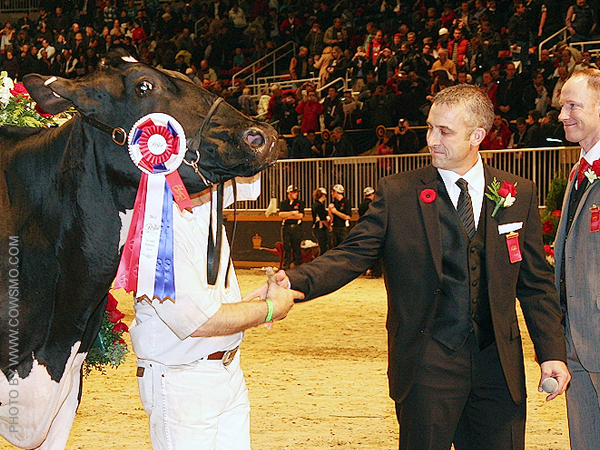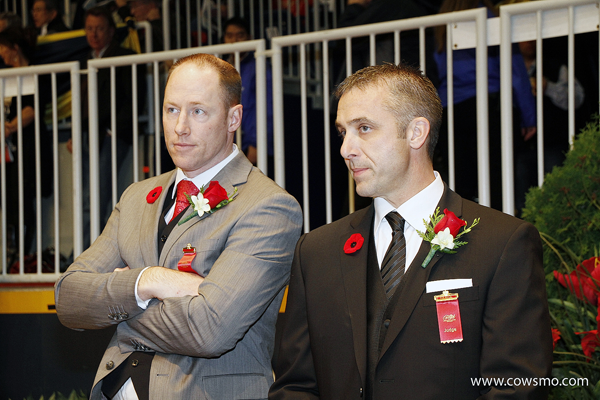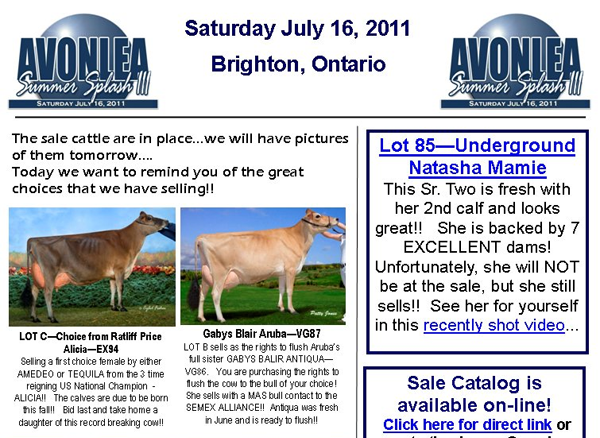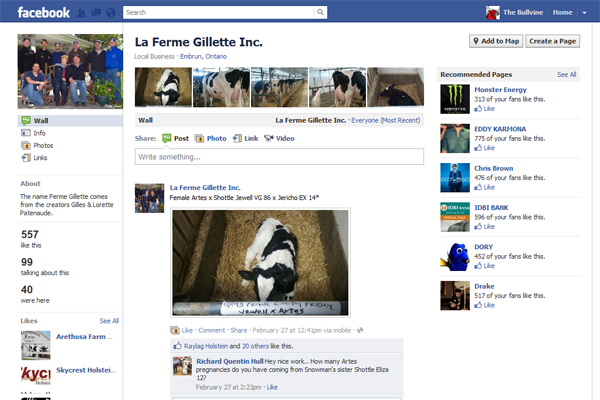Shows
-
Ontario Spring Holstein Show
Mar. 29, 2012
Ancaster, ON
Judge: Adam Liddle, Argyle, NY - Junior Champion: Petitclerc Alexander Abrico (Golden-Oaks ST Alexander), 1st summer yearling, Air America Dairy LLC., NY
- Res. Junior Champion: Benrise Spirte Diamond (Cedarwal Spirte), 1st spring yearling, Benschop Farms, Bowmanville, ON
- Intermediate Champion: Lorneva Paramount Dee (Stanhope Paramount), 1st Jr. 3-year-old, Adam Clarke & Aaron Eaton, ON & NY
- Res. Intermediate Champion: Valleyville Rae Lynn (Genn-Mark Stmatic Sanchez), 1st Sr. 2-year-old, Quality Holsteins, Graja Ponderosa, Al-Be Ro Land & Cattle, ON & Italy
- Grand Champion: Ricardo Dundee Dawnette (Regancrest Dundee), 1st mature cow, Hodglynn Holsteins & Ricardo, Galton & Moo York Cattle, Kincardine, ON
- Res. Grand Champion: Salem Astronomical Justine (Oseeana Astronimcal), 2nd mature cow, Martincroft & Piggot Farms, Bright, ON
- Premier Breeder: Kingsway Farms, ON
- Premier Exhibitor: Mapelwood Holsteins, ON
- Ontario Spring Jersey Show
Mar. 28, 2012
Ancaster, ON
Judge: Mike Phoenix - Junior Champion: Bridon Comerica Victoria (Comerica), Bridon Farms, ON
- Reserve Junior Champion: Leachland Kit Kt K (Minister), Colin & Karen Leach, ON
- HM Junior Champion: Willow Creek Iatola Majesty (Iatola), Willow Creek Jerseys, ON
- Intermediate Champion: Trent Valley Rose (Hired Gun), Trent Valley, Cybil Fisher, Jason Mell, ON, WI
- Reserve Intermediate champion: Bridon Iatola Polish (Iatola), Bridon Farms, On
- HM Intermediate Champion: Meadow Lynn Comerica Nel (Comerica), Meadow Lynn Farms, ON
- Grand Champion: Glen Caro Nan 2 (Millenium), Trent valley Holsteins, Cybil Fisher & Jason Mell, ON, WI
- Reserve Grand Champion: Bridon jades Achieve (Jade), Bridon Farms, ON
- HM Grand champion: Trent Valley Rose (Hired Gun), Trent Valley, Cybil Fisher, Jason Mell, ON, WI
- Premier Breeder & Exhibitor: Willowcreek Jerseys, ON
- Breeders Herd: Bridon Farms, ON
- Ontario Spring Show Showmanship Classes
- Junior Showmanship
1. Matt Lange
2. Mikayle Ringelberg
- Junior Showmanship
- Intermediate Showmanship
1.Peter Leach
2. Cameron Stockdale - Senior Showmanship
1.Christine Armstrong
2. Steven Stockdale - Grand Showman: Peter Leach
- Reserve Grand Showman: Christine Armstrong
- HM Grand Champion: Cameron Stockdale
- Calgary Dairy Classic Show Results
Mar. 24 – Calgary, AB
Judge- Gerald Coughlin, Peterborough, ON - Junior Champion: Starcrest Rhyme Casablanca (Markwell Durham Rhyme), 1st fall yearling, Starcrest Holsteins & Wendon Holsteins, Innisfail, AB
- Res. Junior Champion: Vandyk-K Gold Preppie (Braedale Goldwyn), Kenbert Acres & Jordan Konkel, Drake, SK
- Grand Champion: Crestomere Lou Victoria (Jenny-Lou Marshall P149), 1st 4-year-old, Crestomere Holsteins, Ponoka, AB
- Res. Grand Champion: Wendon Dundee Divina (Regancrest Dundee), 1st 5-year-old, Wendon Holsteins, Innisfail, AB
- HM Grand Champion: Lakefield Winston Jet (Sunday Dur Hyman Winston) 2nd 5-year-old, Continental Holsteins, Leduc, AB
- Premier Exhibitor (tie): Continental Holsteins
- Premier Breeder: Skycrest Holsteins
- Atacama and Pepita Swiss Champions
At the National Holstein Show in Bulle, Switzerland, two candidates from the mature cow class fought for the championship. The French-born Du Bon Vent Stormatic Atacama of Marc & Erhard Junker ultimately triumphed due to her extra quality in dairyness and rear udder. Reserve went to the mighty and balanced cow Ptit Coeur Iron Dirona of GS Alliance. Honorable Mention went to the stylish and youthful Lystel Bolton Lorana of Swisslor.In the Red Holstein Show, two young milking cows drew lots of attention; the refined and super-uddered Bopi Talent Lotanie of Oberson & Savary and the flawless and open-ribbed La Waebera Acme Sublime of Michel Clément. In the finale they finished in second and third respectively and only had to bow for the winner of the queen’s class: Pepita (photo). The reigning European Champion of Everdes Holsteins combined strength with capacity and lots of quality in her udder and legs. (source:holsteininternational.com) - Ohio Spring Dairy Expo- Red & White Show Results
Mar. 29, 2012
Columbus, OH
Judge: Denny Patrick, Woodbine, MD
Total Head: 47- Junior Champion: Richman Destry Dina R28-Red (Scientific Destry-ET*RC), 1st spring yearling, Richman Farms, Lodi, OH
- Res. Junior Champion: Co-Vale Dusk TYA 3845-Red (Scientific SS Dusk-ET*RC), 2nd spring yearling, Clay, Cora, Curtis, Carlie Gunkleman, Medina, OH
- Intermediate & Res. Grand Champion: Semler Advent Scarlett-Red (KHW Kite Advent-Red-ET), 1st Sr. 3-year-old, James Semler, Yellow Springs, OH
- Res. Intermediate Champion: MS Starmark Con Racy-Red-ET (Patience Showline Contender-Red), 1st Jr. 2-year-old, Starmark & Mark Rueth
- Senior & Grand Champion: Miley Advent B Gem-Red (KHW Kite Advent-Red-ET), 1st 4-year-old, Anna Miley, West Salem, OH
- Great Lakes Spring Show Champions
Mar. 24 – East Lansing, MI
Judge- Barclay Phoenix, Uxbridge, ON
102 Head Shown- Junior Champion: Minsu Tee Off Bubble (Rietben Tee Off-ET), 1st spring yearling, T&H Dairy, Fowler, MI
- Res. Junior Champion: Mapel Wood Fever Bombino (Crackholm Fever), 2nd spring yearling, Hardys Holsteins, Tipton, MI
- Intermediate Champion: Tri-Koebel Roy Elaborate (Roylane Jordan), 1st Sr. 3-year-old, Greta Koebel, Three Oaks, MI
- Res. Intermediate Champion: Minsu Lucky Star Kathy (Bofran Lucky Star-ET), 2nd Sr. 3-year-old, T&H Dairy, Fowler, MI
- Grand Champion: Tri-Koebel Fear This-ET (Sunnylodge Linjet), 1st Aged Cow, Tera Koebel, Three Oaks, MI
- Res. Grand Champion: Hardys Goldwyn Destiny-ET (Braedale Goldwyn), 1st 4-year-old, Parker Hardy, Tipton, MI
- Premier Exhibitor (tie): Long-Haven Farms, Hardys Holsteins
- Premier Breeder: Long-Haven Farms
- Pennsylvania Spring Show
March 24, 2012
Harrisburg, PA
Judge: Chip Savage- Junior Champion: Sweet Peas Asteroid Amber (Asteroid), 1st Winter Yearling, Matthew Pease
- Reserve Junior Champion: Rolling Spring Schz Ella-ET (Sanchez), 1st Spring Yearling, Charles Bean
- Intermediate Champion: Windy Knoll View Pollyanna (Laramie), 1st Senior 3 Year Old, James & Nina Burdette
- Reserve Intermediate Champion: Heart&Soul C Me Im Radiant (Contender), 1st Junior 3 Year Old, Douglas & Jennifer Boop
- Grand Champion: Windy Knoll View Panini-ET (Goldwyn), 1st 4 Year Old, James & Nina Burdette
- Reserve Grand Champion: Valleys-End Leader Emily (Leeder), 1st Aged Cow, Mark Hough
- Premier Breeder & Exhibitor: Windy-Knoll-View
- Winning first crop daughter
It is not often that a first crop daughter triumphs in the show ring. At the RMV Schau in Germany, that was exactly what Grandiose did. The very fancy looking, second-calver daughter of the German Goldwyn son Gunnar comes from the herd of Am Recknitztal. The Reserve title went to the fifth-calver Derry daughter BcH Biggi of Augustin. (source:holsteininternational.com)
Sales
- Taste of Ontario Tag Sale 2012
March 26th to 29th, Cranston Farms, Hosted by Cranston Farms and Jeff Stephens - Lot 3 – December ’11 Sanchez x EX 90 Goldwyn x The Spotties SOLD TO GLEN KRANTZ CLAREMOUNT HOLSTEINS
- Lot 4 – Sold to Rick Allyn, CT for $6,000
- Lot 8 – Windbrook x VG89 Goldwyn x 4 more VG/EX Dams. Sold to Brad Eggink, Niagara ON for $7,500
- Lot 9 – Sold to Jake Jansema, Niagara ON.
- Lot 11 – December ’11, Lot 11 Goldwyn x EX Dundee from Leachland Gold Medal Family. Sold to Brook and Lindsay Clarke, NH. $7500
- Lot 12 – Sold to John Hedden, ON. $6,500
- Lot 13 – 1st Choice sold to Greg Archibald, NB for $10,000. 2nd Choice available.
- Lot 14 – Sold to Gary Troup, Vale-O-Skene, Dean Mcmorrow, Jason Pegg, Rick Carberry for $25,000
- Lot 16 – Sept ’11 Goldwyn x Fleury Formaton Lauria EX95 3E. Full Sister to Brainwave Goldwyn Lauramie- SOLD TO DAN DEWITT, WI $12,50
- Lot 18 – also sold to Larry Krantz, Carldot Farms, Stratford , ON
- Lot 20 – Sold to Adam Clarke
- Lot 27 – June ’11 Aftershock x VG 86 2yr Goldwyn x EX93 Aspen -SOLD TO ALLSTAR GEN $7000
- Lot 28 – Sold to Larry Krantz, ON for $6,500
- Lot 29 – June ’11 Goldwyn with 3 EX dams – SOLD TO JUSTIN HINZ, NY $10,000
- Lot 38 – June ’11 Windstorm X VG86 x EX Outside x EX Astronomical SOLD TO TODD FREEMAN INDIANA, USA $6000Lot 50 – Sold to Lesperron Holsteins & Ferme Yves Croteau, Que for $25,000
- Lot 59 – Sept ’10 Primetime x Pleasant Nook Sambo Teal EX94 5E. Due September 14/12 to Impression SOLD TO RAPID BAY JERSEYS, QC $10,000
- Lot 60 – Furor Sept Calf x 1st Foundation W Rose VG-88 x Bovilact Grove Primrose EX-90 plus 3 more VG or EX Dams -SOLD TO MT ELGIN DAIRY, ON $4000
- Also 2 of the Florian display daughters sold
- Premier Edition Sale Averages $2,860
The Premier Edition Sale was held Friday, March 23, 2012 in Calgary, Alberta, Canada. Managed by Western Dairy Connection, Erik & Carla Klugkist, the sale averaged $2,860. The top seller was a 54 inch super fancy R&W summer yearling by Secure from a VG-87 Advent, with the next 5 dams all EX back to Raven. This heifer brought $13,700, consigned by Morcrest Farms of Didsbury, AB and bought by Westcoast Holsteins of Chilliwack, BC. (source:holsteinworld.com)
Following is a list of other high sellers: - $5700- Lot 7A -1st Choice of 5 Secure female pregnancies (full sisters to top seller) due June 2012 x Markwell Advent Raina VG-87 x Jr Rainbowd Red EX-90 2E with 4 more EX dams including Raven
Buyer: Wrightside & Rod York, AB, SK
Consignor: Morcrest Holsteins, AB - $4200- Lot 70 (added entry) Willowest Durham Faith VG (Durham x Markwell Outside Fay EX x Rudolph Rarity x Thor Renee x Raven)
Buyer: Searock Dairy, AB
Consignor: Prinse Farms, BC - $4100- Lot 62 Coytee Shottle Brandi (Shottle due Jun 2012 to Dempsey x Bienert Gibson Bambi VG-87 plus 6 more gen VG or EX)
Buyer: Shane Straub, AB
Consignor: Coytee Holsteins & Bienert Holsteins, AB - Earthquake
A fantastic average of $13,740 (over more than 100 lots) was achieved at the California Earthquake Sale with the top seller going for $150,000. This was a daughter of the Freddie son Lewis from Ladys-Manor Planet Shandra. The runner-up ($125,000) was the show cow Pierstein Goldwyn Frisou. (source:holsteininternational.com)
Top 10 prices more high sellers on the day below photos: - Lot 13 – $150,000 – Furnace-Hill Lewis Shes Sam +2617 GTPI Lewis daughter of Ladys-Manor Pl Shandra-ET (VG-85 GTPI +2400) – #4 GTPI heifer in the breed!
- Lot 1 – $125,000 – Pierstein Goldwyn Frisou VG-89-CAN – will show as a 5-Year-Old this year!
- Lot 14 – $70,000 – Bacon-HIll Ostyle Monica-ET, a 12/11 O-Style at +2380 GTPI out of Unique-Style Bolton Money (EX-91 GTPI +2296)
- Lot 17 – $62,000 – Pencroft-Ammon GC Cierra-ET, a 10/11 Gold Chip that is the #1 Type heifer in the breed at +5.00T. Her dam – Ammon Farms Mac Classic-ET is now EX-90.
- Lot 21 – $58,000 – 1st choice Numero Uno out of Sandy-Valley Robust Ruby-ET +2575 GTPI out of VG-87 Planet Sapphire
- Lot 2- $50,000 – 1st choice Goldwyn due 9/2012 from 2011 All-American 4-Year-Old RockyMountain Talent Licorice (EX-92)
- Lot 23 – $42,000 – 2nd choice Numero Uno or Epic from De-Su 199 Chart Topper-ET +2650 GTPI – the #1 GTPI female in the breed
- Lot 18 – $38,000 – Le-O-La Shamrock Pebbles-ET, a 10/11 +2407 GTPI Shamrock – the #12 Shamrock in the breed
- Lot 15 – $36,000 – Farnear Gold Chip 1407, a 12/11 Gold Chip +2435 GTPI out of Ms Apple Brandy-ET +2188 GTPI Shottle daughter of Apple!
- Lot 38 – $35,000 – Butlerview SR Juna-ET, a 12/11 Shamrock at +2431 GTPI out of Coyne-Farms Feddi Jeven-ET +2269 GTPI
- Best Sunrise ever
Many happy faces in Karow, Germany: With a sale average of €8065 the 17th Sunrise Sale was the best edition ever. The top-selling calf was Morsan Observer Dolly (Observer x Socrates x Goldwyn) selling for €27,000 to Genes Diffusion in France. A Snowman from the Jocko Benge family sold for €22,000. (source:holsteininternational.com) - Waupaca-Waushara Show Opportunity Sale Averages Over $1,900
A Snowman fall calf consigned by Sandy-Valley Farms, Scandinavia, topped the 26th annual Waupaca-Waushara Show Opportunity Sale at $5,000. Hosted by the Waupaca-Waushara Holstein Breeders Association, the sale took place March 17th at the Waupaca County Fairgrounds, Weyauwega. The sale averaged $1,936 on 45 lots. (source:holsteinworld.com) - The top seller, Sandy-Valley Snowcam-ET, carries a GTPI of +2145, and is out of Shema Mac Camille-ET VG-86, who has several daughters with GTPIs over +2200. She was purchased by Michael Hughes, Pickett.
- Luke Erb, Shiocton, paid $4,300 for the second-high seller, Stone-Front Gold Pinto-ET, a July heifer consigned by Andrew and Lynette Buttles, Lancaster. The maternal sister to this heifer is the renowned Stone-Front Iron Pasta EX-96 2E, the Reserve Grand Champion of the International Holstein Show at World Dairy Expo in 2010. Pasta was the All-American 125,000-pound cow in both 2010 and 2011 and was also All-Canadian Mature Cow in 2011.
- Sandy-Valley Farms also consigned the third-high seller for $3,200 with Sandy-Valley Bokm Britny-ET, who carries a GTPI of +2038. Purchased by Debbie Garcia, Scandinavia, her dam is Regancrest G Beauty-ET, the #4 PTAT Cow of the breed since Dec. 2011. The next dam is the well-known Regancrest-PR Barbie-ET, the Honorable Mention Junior 3-year-old in 2004.
- Gala II at Glen Valley Sale a Success!
The Gala II at Glen Valley Sale was held March 24th in Atglen, PA, at the home of Ken & Marilyn Umble and family and averaged $2885 on 141 full lots. The 22-year PBR award winning herd sold with a last DHI test day average of 90 lbs. High selling animal of the day was Lot 10, Golden-Rose Shot Romance-ET, a just-fresh Shottle who is a potential 17th generation EX! Romance is out of Oakfield Pronto Ritzi (EX-90), who made a 3-01 record of 290d 31,104 3.4 1055 3.0 943 (Inc.), and traces back to the world-famous Pinehurst Royal Rosa (2E-91) family. Romance was purchased by The Romance Partners, c/o Eric Evans, Buhl, ID, for $10,000. Also highlighting the sale were her 2/12 Goldsun daughter selling for $5300 and her 1/12 Goldwyn with GTPI 2030 selling for $6800. Many members of the Glen-Valley Win Caprice (3E-93 GMD-DOM) family sold, including the second and third high sellers at $7600 and $7000 respectively. Glen-Valley Ross Caliste is an Altaross daughter of Glen-Valley Lou Calixte-ET (EX-91). Caliste was carrying an ultrasound female by Epic and has a GTPI of 2095. Her first choice Numero Uno was then sold, with buyer’s choice of females from 2 pregs due 9/12 and 3 more transfers on 1/12. A special moment in the sale came when two lots from the Glen-Valley Rubens Sprinkle (2E-91) family sold. Sprinkle was owned by Jordan Umble, Ken & Marilyn’s middle son who was killed in a motorcycle accident in 2006. Proceeds from CC-Jordan Snowstorm-Red and a Braxton choice from Sprinkle (totaling $6450) went to the Jordan M. Umble Memorial Mission Fund. The standing room only crowd was treated to complimentary home-made ice cream, and a pre-sale coffee & donuts social hour. The sale was managed by The Cattle Exchange, with David Rama and Horace Backus working the box, assisted by Dan Brandt, David J. Lentz, Nick Raggi, Dave Bitler and Don Welk in the ring. (source:holsteinworld.com) - Border & Lakeland Club Show & Sale – Boclair Tops With Elegance
The March Border & Lakeland Dairy sale held at Borderway Sale Centre once again proved to be a top event with both buyers and sellers going home with their goals achieved. The show was judged by one of the breeds more experienced personalities Mr Tecwyn Davies from the Caeremlyn herd in South West Wales. - His Champion was Boclair Dancer Beatrice 2, a strong powerful heifer with a super udder bred from three Excellent dams with yields over 13,000kgs. The Champion was consigned by David Brewster and was purchased by JB Marshall, Auchenleck, Castle Douglas.
- Mr Davies Reserve Champion was Holywood Scooby Crimson bred by Robert Whiteford and consigned by David Hodgson from the Wormanby herd. She was a silky black heifer with a lot of style and sired by Go-Farm Allen Scooby-Duu and sold for 2,500gns to N&SJ Sanderson, Burtholme Farm, Brampton.
- Winning the Junior heifer in milk class was another heifer from David Brewster, Boclair Bolton Elegance was bred from the world renowned Krull Broker Elegance EX96. This heifer is potentially the sixth generation of Excellent and she sold for the top price of the day 3,200gns to Messer Bryson, Whiteflatt Farm, Ayrshire.
- The Telfer family from High Branchal, Bridge of Weir had a special offering from their popular Branchal herd. Topping this wonderful consignment was a heifer sired by Aquila Patron Lucente from the Divina family, she now joins the herd of J Baxter, Gibblaston Farm, Renfrewshire for 2,550gns. Another Branchal heifer sold for 2,500gns going to N&SJ Sanderson, Burtholme Farm, Brampton she was a daughter of Annandale Keiser from the Katkin family.
- Other consignments included a truck load from N. Scott from the Niscot herd in Aberdeenshire they sold to an average of just over £2000 with top price of 2,500gns for a daughter of the up and coming Firth Bullion. This heifer was Niscot Bullion Joan bred from a VG88 dam with over 70 tons of milk lifetime, she now joins the herd of A&I Lamont, Sandieston Farm, Renfrewshire.





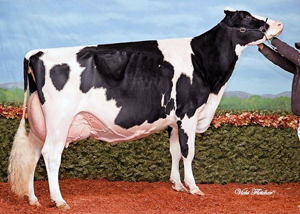


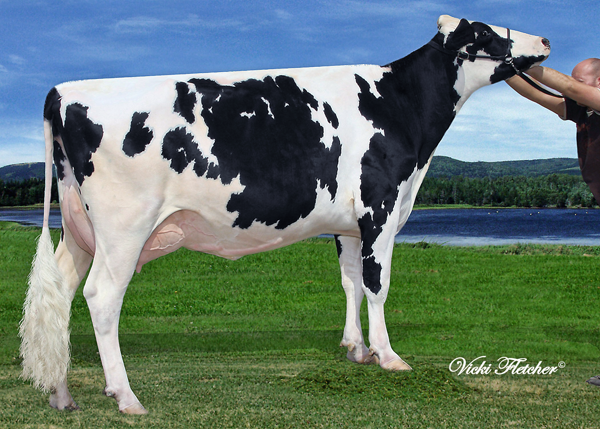
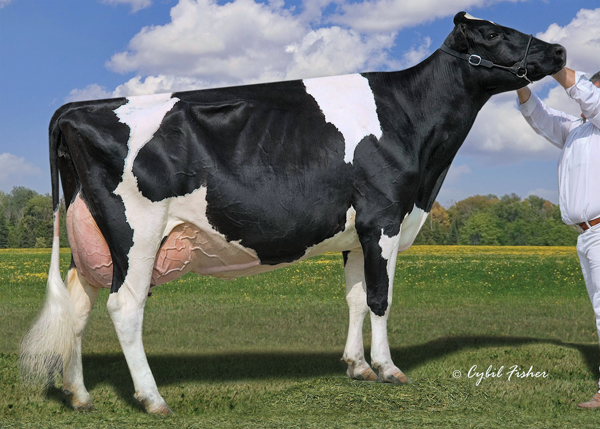
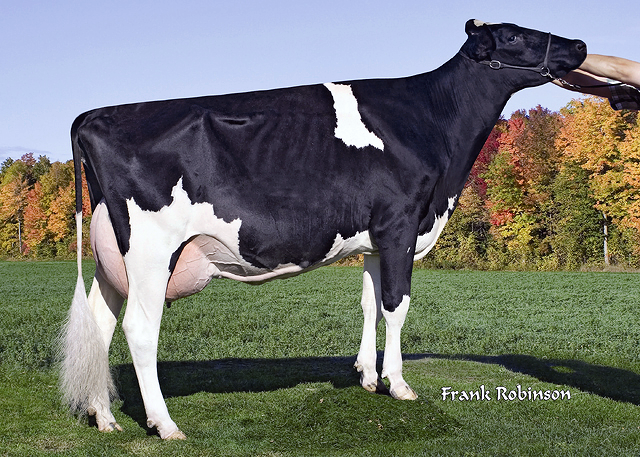

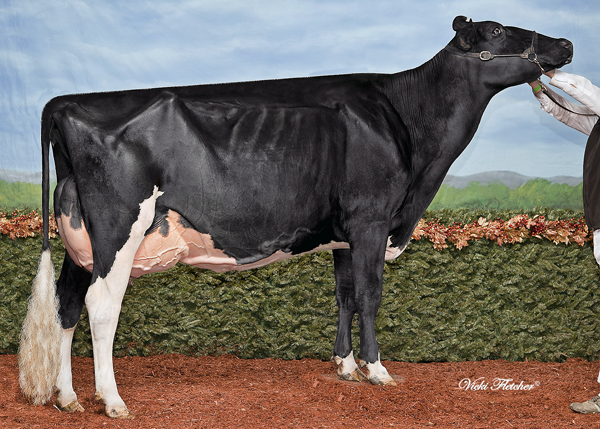
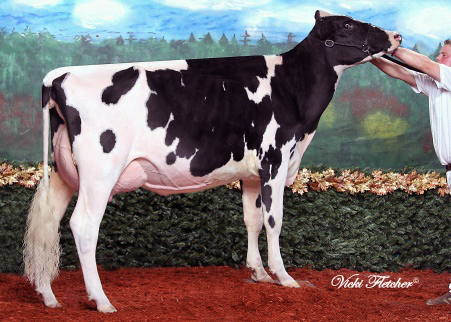
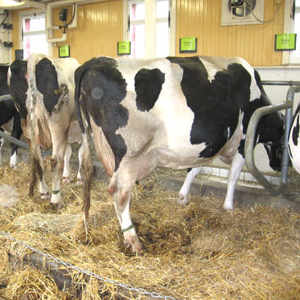 In order to get maximum results from their genetics programs, many top programs needed to have their top cattle score significantly higher than the other animals scored that same day. While many people deemed these herds “Hot Houses”, in reality they are just working the BLUP system to get maximum results. Since the calculations also took into account the genetics of the other animals scored, these “hot house” herds needed to have daughters of high type bulls that would score lower than the selected cattle that were typically sired by bulls with lesser conformation scores. For example, you have a low value cow sired by a +14 conformation sire that goes 79 points, and a high conformation cow sired by a +6 conformation sire that goes 86 points. This would provide the selected cow with the greatest difference over the expected value and have significant improvement in their EBV for conformation and thereby in their overall total merit.
In order to get maximum results from their genetics programs, many top programs needed to have their top cattle score significantly higher than the other animals scored that same day. While many people deemed these herds “Hot Houses”, in reality they are just working the BLUP system to get maximum results. Since the calculations also took into account the genetics of the other animals scored, these “hot house” herds needed to have daughters of high type bulls that would score lower than the selected cattle that were typically sired by bulls with lesser conformation scores. For example, you have a low value cow sired by a +14 conformation sire that goes 79 points, and a high conformation cow sired by a +6 conformation sire that goes 86 points. This would provide the selected cow with the greatest difference over the expected value and have significant improvement in their EBV for conformation and thereby in their overall total merit. With the introduction of genomic evaluations in August 2009, the effects that any “hot house” efforts can have has been reduced in the genetic indexing systems. This is because for young cows in first or second lactation, the relative weighting for Direct Genomic Value (DGV) compared to traditional Estimated Breeding Values (EBV) is roughly 55:45 (
With the introduction of genomic evaluations in August 2009, the effects that any “hot house” efforts can have has been reduced in the genetic indexing systems. This is because for young cows in first or second lactation, the relative weighting for Direct Genomic Value (DGV) compared to traditional Estimated Breeding Values (EBV) is roughly 55:45 (
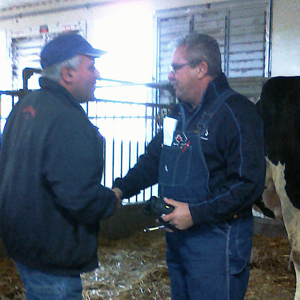 UDDERLY EXCELLENT
UDDERLY EXCELLENT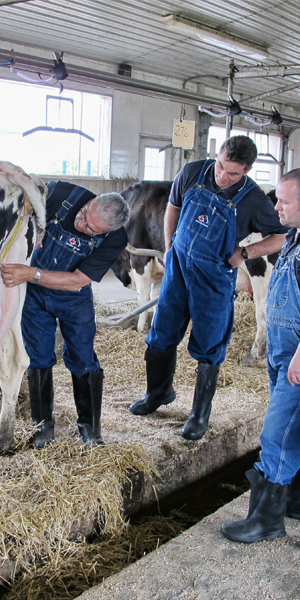 FACING FORWARD WITH CLASSIFICATION
FACING FORWARD WITH CLASSIFICATION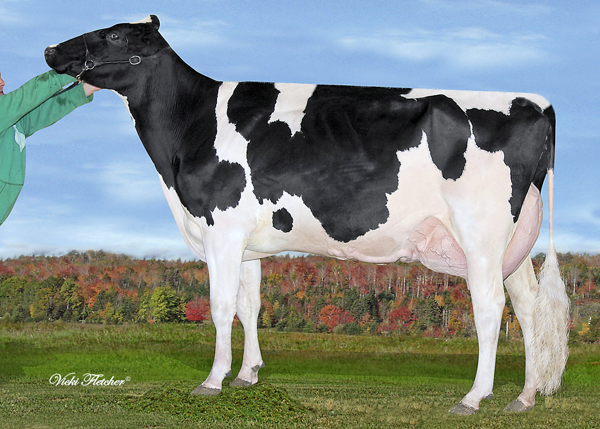
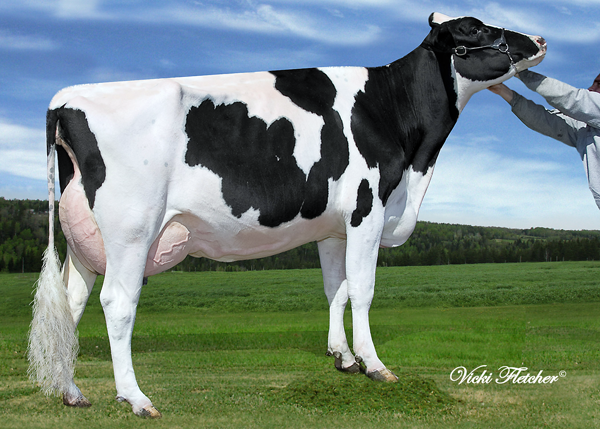
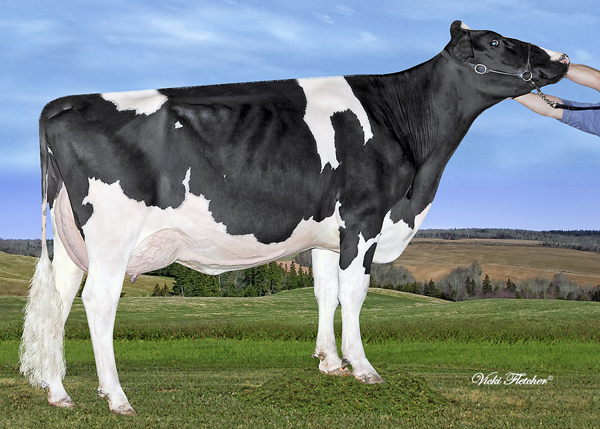
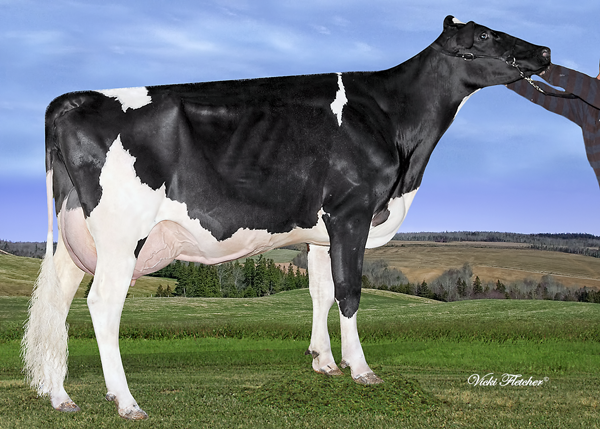



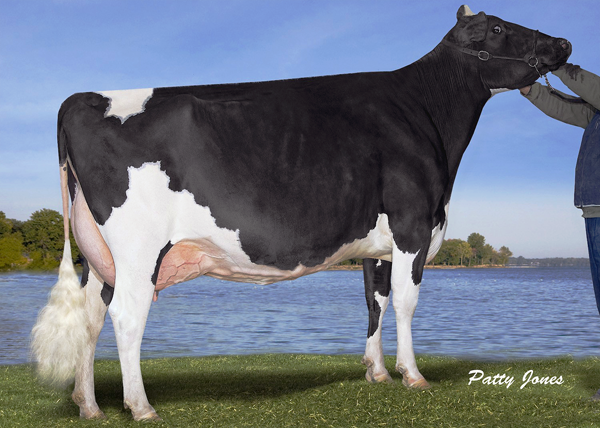
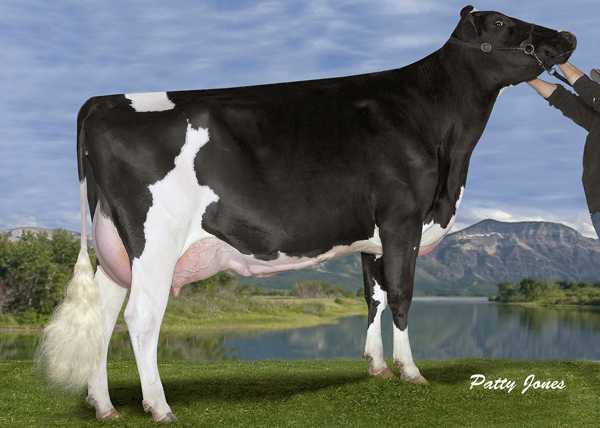

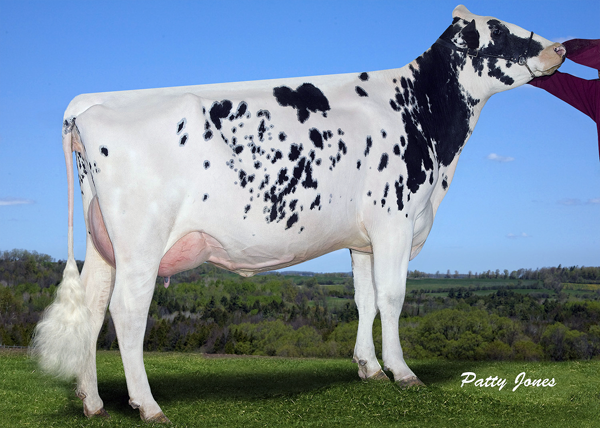

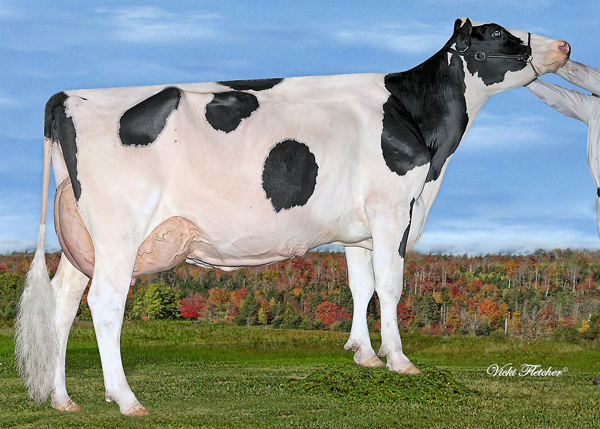
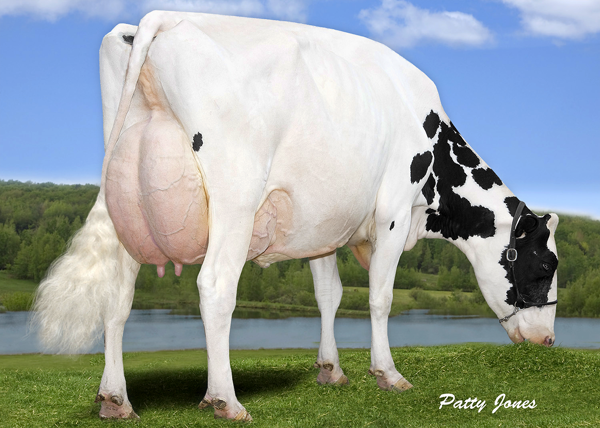

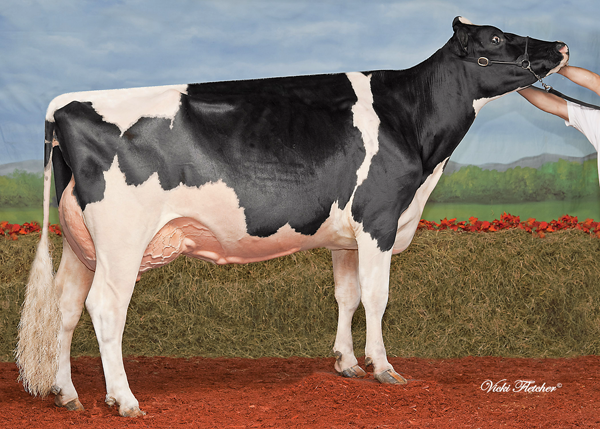
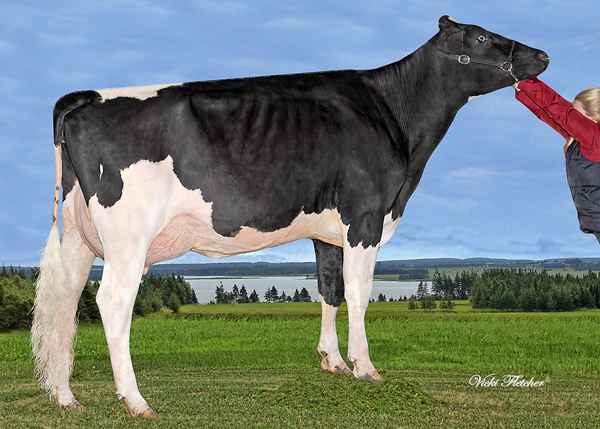
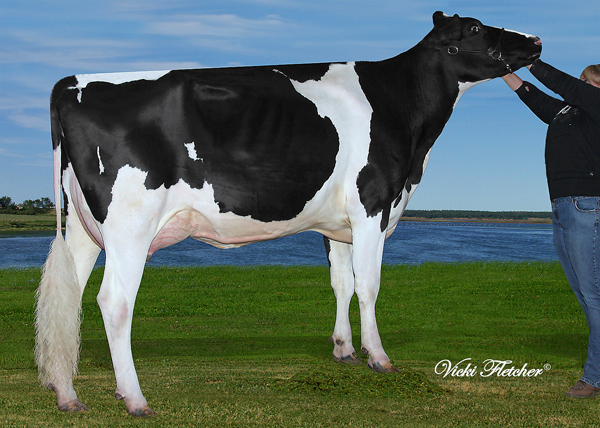
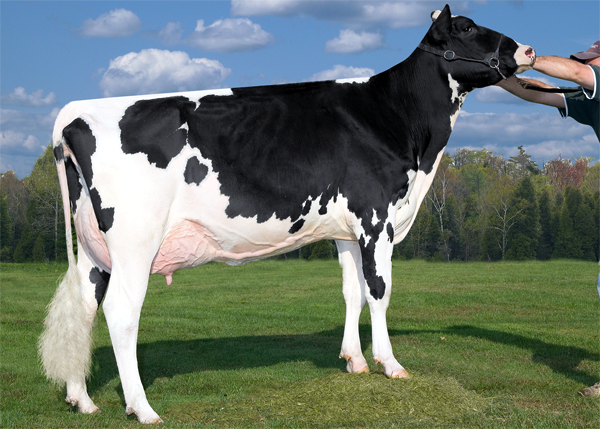
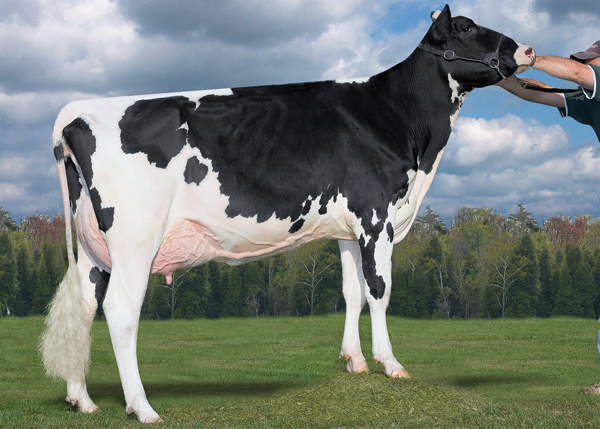
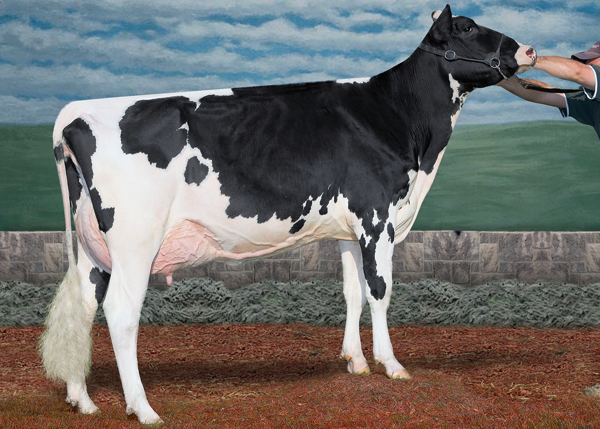
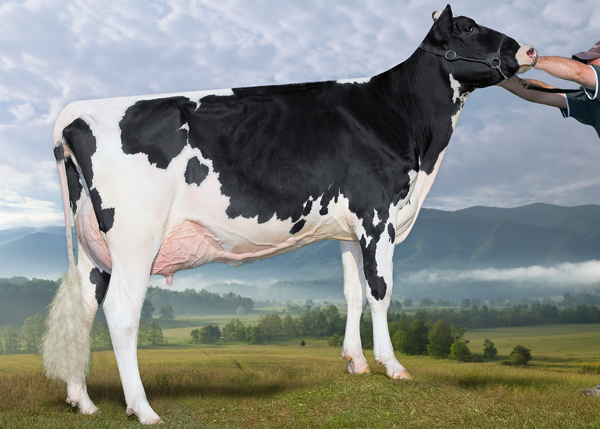
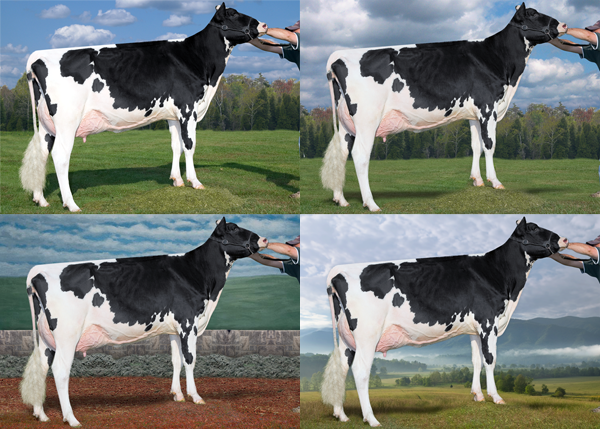
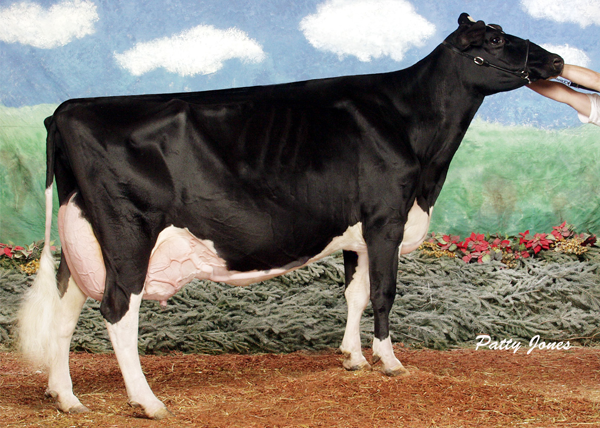
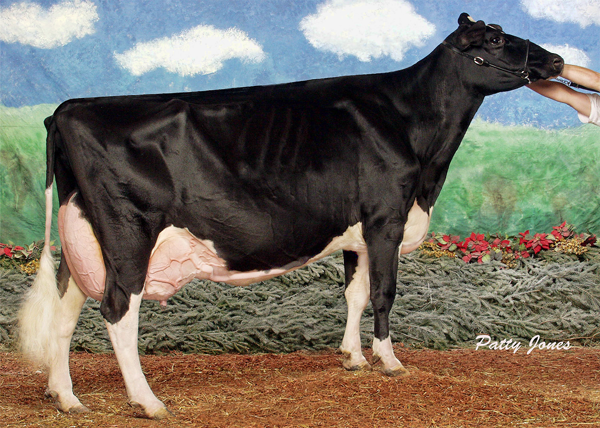
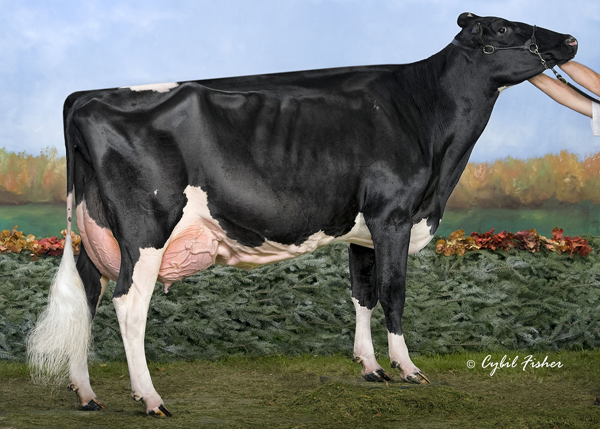
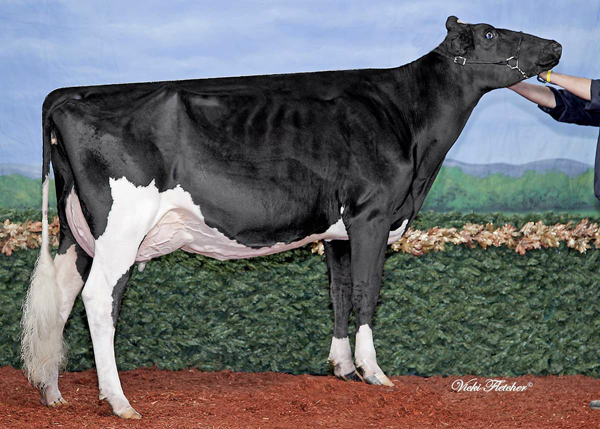
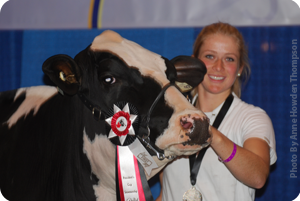 Twenty-five year old Cristy grew up on her parent’s dairy farm, Monteith Holsteins, in Georgetown, Ontario. “My parents exhibit both dairy cattle and Clydesdale horses, so I became involved with competing at an early age. I also began competing in hunter/jumper competitions when I was young and continued to keep a horse and compete until late in high school. Through 4-H my sister and I also acquired and began breeding and showing sheep, so we truly had a well-rounded experience in terms of animal care and competition.”
Twenty-five year old Cristy grew up on her parent’s dairy farm, Monteith Holsteins, in Georgetown, Ontario. “My parents exhibit both dairy cattle and Clydesdale horses, so I became involved with competing at an early age. I also began competing in hunter/jumper competitions when I was young and continued to keep a horse and compete until late in high school. Through 4-H my sister and I also acquired and began breeding and showing sheep, so we truly had a well-rounded experience in terms of animal care and competition.”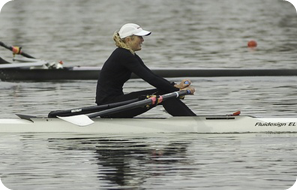 After playing a year of varsity basketball at the University of Guelph, I was looking for a new sport and a new challenge. At the Don Rowing Club Cristy recalls, “I took to the sport very quickly and began to have race and physiological testing results that caught the attention of the national team coaches. By 2010 I was invited to move to the National Training Centre in London, Ontario.” This has meant raising the bar on her goals. “Right now, I am in Olympic Selection Camp, which is essentially a narrowed-down group of athletes who are still in contention for spots on the Olympic team. I won’t know until the end of May if I will be on the Olympic team, so my biggest goal right now is to be re-selected to the women’s 8. And, of course, to stand on the podium at the London games if I do so.”
After playing a year of varsity basketball at the University of Guelph, I was looking for a new sport and a new challenge. At the Don Rowing Club Cristy recalls, “I took to the sport very quickly and began to have race and physiological testing results that caught the attention of the national team coaches. By 2010 I was invited to move to the National Training Centre in London, Ontario.” This has meant raising the bar on her goals. “Right now, I am in Olympic Selection Camp, which is essentially a narrowed-down group of athletes who are still in contention for spots on the Olympic team. I won’t know until the end of May if I will be on the Olympic team, so my biggest goal right now is to be re-selected to the women’s 8. And, of course, to stand on the podium at the London games if I do so.”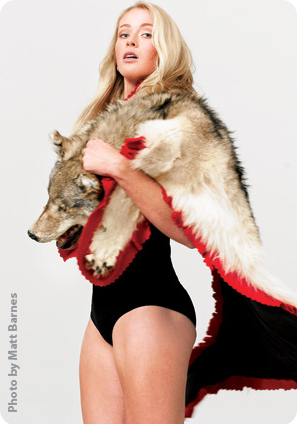
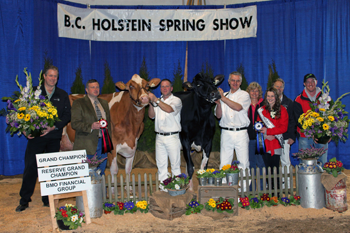
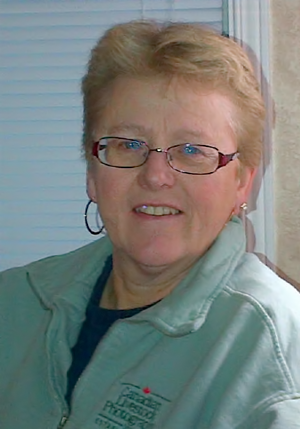 Patty Jones has a passion for cows and for people who share that passion. “I work with a lot of new young farmers. I tell them off the bat what they need to do.” And she says they listen and pay attention. No doubt they recognize that with nearly forty years of experience photographing between 60 and 65000 cows, she knows what she’s talking about. Even longtime clients of Canadian Livestock Photography occasionally forget details. Patty says the young guys know this is important. “I wouldn’t be working if I didn’t help my clients make money. They’re not just taking pictures for the hell of it”! She is sincere about what everyone is aiming for. “If I can help farmers, especially the younger guys, to get going and make a little bit more out of their investment. What the heck? That’s what I do it for.”
Patty Jones has a passion for cows and for people who share that passion. “I work with a lot of new young farmers. I tell them off the bat what they need to do.” And she says they listen and pay attention. No doubt they recognize that with nearly forty years of experience photographing between 60 and 65000 cows, she knows what she’s talking about. Even longtime clients of Canadian Livestock Photography occasionally forget details. Patty says the young guys know this is important. “I wouldn’t be working if I didn’t help my clients make money. They’re not just taking pictures for the hell of it”! She is sincere about what everyone is aiming for. “If I can help farmers, especially the younger guys, to get going and make a little bit more out of their investment. What the heck? That’s what I do it for.”